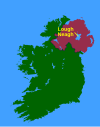Lough Neagh
| Lough Neagh | |
|---|---|
| Location | Northern Ireland |
| Coordinates | 54°37′06″N 6°23′43″W / 54.61833°N 6.39528°W |
| Catchment area | 4550 km² |
| Basin countries | United Kingdom (91%) Republic of Ireland (9%) |
| Max. length | 30 km |
| Max. width | 21 km |
| Surface area | 388 km² |
| Average depth | 9 m |
| Max. depth | 25 m |
| Islands | Coney Island, Coney Island Flat, Croaghan Flat, Derrywarragh Island, Padian, Ram's Island, Phil Roe's Flat and The Shallow Flat |
Lough Neagh (Template:PronEng, Irish: Loch nEathach, meaning 'Lake of Eochaidh',[1] IPA: [ɫ̪ɔx ˈn̠ʲahax]) is a freshwater lake in Northern Ireland. With an area of 392 square kilometres (151 square miles), it is the largest lake in the British Isles and ranks among the forty largest lakes of Europe. Located 30 km (20 mi) to the west of Belfast, it is approximately 30 km (20 miles) long and 15 km (9 mi) wide with an area of 392 square kilometres (151 square miles). It is very shallow around the margins and the average depth in the main body of the lake is about 9 m (30 ft); although at its deepest the lough is about 25 metres (80 ft) deep.
Of the 4550 km² catchment area, around 9% lies in the Republic of Ireland and 91% in Northern Ireland;[2] altogether 43% of the land area of Northern Ireland is drained into the lough,[3] which itself flows out northwards to the sea via the River Bann. As one of its sources is the Upper Bann, the Lough can itself be considered a part of the Bann.

Five of the six counties of Northern Ireland have shores on the Lough: Antrim, Armagh, Down, Londonderry and Tyrone. Towns and villages near the Lough include Antrim, Crumlin, Randalstown, Toomebridge, Ballyronan, Ballinderry, Moortown, Ardboe, Maghery, Lurgan and Magherafelt.
Although the Lough is used for a variety of recreational and commercial activities, it is exposed and tends to get extremely rough very quickly in windy conditions. It is also used as a source of fresh water by the DRD Water Service. Plans to increase the amount of water drawn from the Lough, through a new water treatment works at Hog Park Point, have long been planned but are yet to materialise.
Traditional working boats on Lough Neagh include wide-beamed 16–21ft clinker-built, sprit-rigged working boats and smaller flat-bottomed "cots" and "flats". Barges, here called "lighters", were used up to the 1940s to transport coal over the lough and adjacent canals. Up to the 17th century, log boats (coití) were the main means of transport, some of which are as old as 6,400 years. Few traditional boats are left now, but a community-based group on the southern shore of the lough is rebuilding a series of working boats.[4]
In the 19th century, three canals were constructed, making use of the lough to link various ports and cities: the Lagan Navigation provided a link from the city of Belfast, the Newry Canal linked to the port of Newry, and the Ulster Canal led to the Lough Erne navigations, providing a navigable inland route via the River Shannon to Limerick, Dublin and Waterford. The Lower Bann was also navigable to Coleraine and the Antrim coast, and the short Coalisland Canal provided a route for coal transportation. Of these waterways, only the Lower Bann remains open today, however a restoration plan for the Ulster Canal is currently in progress.
Lough Neagh Rescue provides a Search & Rescue service 24 hours a day. It is a voluntary service with funding being provided by the District Councils bordering the Lough, its members are highly trained and are a declared facility for the Marine Coastguard Agency who co-ordinate rescues on Lough Neagh Maritime and Coastguard Agency.

Lough Neagh attracts bird watchers from many nations due to the number and variety of birds which winter and summer in the boglands and shores around the lough.
Eel fishing has been a major industry in Lough Neagh for centuries. Today Lough Neagh eel fisheries export their eels to restaurants all over the world.
There are a number of islands in the lough: Coney Island, Coney Island Flat, Croaghan Flat, Derrywarragh Island, Padian, Ram's Island, Phil Roe's Flat and The Shallow Flat. (Note: list incomplete)
Lough Neagh was widely assumed to be owned by the state, but in 2005 it publicly emerged that it is the ancestral property of the Earl of Shaftesbury. This may have serious implications for planned changes to state-run domestic water services in Northern Ireland, as the lough supplies 40% of the region's drinking water and is also used as a sewage outfall (in a system only permissible through British Crown immunity).[5]
Legend
An old Irish story tells how the Lough was formed when Ireland's legendary giant Fionn mac Cumhaill (sometimes known as Finn McCool) scooped up a portion of the land and tossed it at a Scottish rival. He missed, and the chunk of earth landed in the Irish Sea, thus creating the Isle of Man.
See also
References
- ^ Deirdre Flanagan and Laurance Flanagan, Irish Placenames, (Gill & Macmillan Ltd, 1994)
- ^ Environmental Change Network
- ^ Northern Ireland Rivers Agency
- ^ Lough Neagh Boating Heritage Association
- ^ BBC NEWS | Northern Ireland | Sudden death may impact NI water
